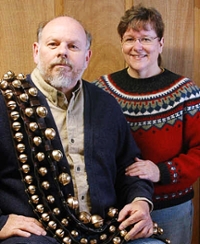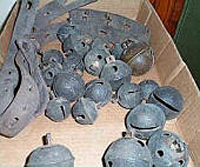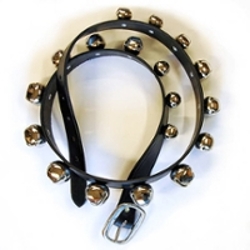Classic Bells: Continuing the Holiday Tradition with Brass
 Artists and Classic Bell owners Charles and DeeAnna Kelly.
Artists and Classic Bell owners Charles and DeeAnna Kelly.This time of year, the lyrics of Sleigh Bells, Jingle Bells, Winter Wonderland and other Christmas songs recall those olden times when people enjoyed riding in horse-drawn sleighs on their way to grandma’s house or to visit friends. Nostalgic cards depict rosy cheeks and smiles capturing the excitement of those simpler days. Pleasure drives in fashionably warm clothes, handsome sleighs, well-groomed horses with nicely polished harness and bells made of brass meant fun in the great outdoors.
Horse bells were considered practical as well as decorative. They warned pedestrians and other drivers about the approach of oncoming vehicles. Street vendors and delivery wagons alerted customers when they were in the area. Bells were used worldwide to enhance the natural beauty of horses that wore them. It was thought they attracted good luck, protected against disease, injury and evil plus flaunted the owner’s wealth and status. Horse bells have been discovered that date back as far as Roman times.
 Box of antique sleigh bells and their original strap waiting for restoration.
Box of antique sleigh bells and their original strap waiting for restoration.U.S. sleigh bell production began to grow strongly early in the 1800s since they were used for recreation and work. William Barton is credited with starting the industry in East Hampton, Connecticut, about 1810 when he opened a foundry to make beautifully decorated sleigh bells using traditional sand casting techniques. Others learned the trade from him and eventually East Hampton earned the worldwide nickname of “jingletown.”
By the late 1800s, the many bell makers of East Hampton provided 90% of the world’s sleigh bells. These Victorian era bell makers were prolific innovators and shrewd businessmen - they wanted to cut costs and boost sales. To reduce labor and materials, they invented machinery to stamp bells from thin sheet brass. To boost sales and edge out the competition, they sold sleigh bells in a wide variety of fanciful shapes.
By the early 1900s almost all U.S. bell manufacturers had disappeared when horses gave way to cars as the main transportation. Streets once filled with horse-drawn carriages became lined with automobiles instead. Only Bevin Brothers Manufacturing Company in East Hampton remains in business today.
Several years ago, Charles Kelly and his wife, DeeAnna Weed, were looking for sleigh bells for their Norwegian Fjord horses.
 A standard strap of 18 bells, by Classic Bells.
A standard strap of 18 bells, by Classic Bells.“I didn’t like the weight and sound of the new bells but the old ones were usually in pretty bad shape,” says Kelly. “I searched for someone that could restore the antiques but no one seemed to specialize in that service. I figured that others might want this, too, and my business idea was born.”
For several months, DeeAnna watched old, grimy, decrepit bells arrive. “I thought it was just another of Chuck’s whims and I didn’t really have much interest in the bells. When he included me in his plan and asked me to help him develop a sleigh bell restoration business, however, I said yes.”
Today, their business Classic Bells restores, designs and constructs bell straps, heirloom-quality home decor, personal items and gifts in their Iowa workshop. Work is custom made, mostly restoring bells for customers who have purchased them at antique stores, flea markets or perhaps inherited as family heirlooms. American sleigh bells made in the last two centuries are brass or bronze. According to DeeAnna, “We buy antique sleigh bells from private individuals, estates and online auctions. Most of these antiques are brass with a high copper content (red brass) or bronze (copper-tin). From my research and information obtained from old patents, I suspect many are bronze. I can’t usually tell the difference between alloys so I use both as possibilities when I describe the metal composition. New bells are a low copper brass (cartridge brass). Antiques have a wider variation in tone, all other things being equal. They tend to have a lower pitch than new ones of the same size. The warm color tones of the antique bells (red brass or bronze alloy) are always lovely!”
“In the beginning we cleaned our bells by hand but the process was tedious and labor intensive,” Dee Anna confides. “The bells didn’t look pretty on the outside and were still dirty on the inside. We realized that we were trying to do too much in a single step. So we incorporated a five-step restoration technique. First, the bells are soaked in a water based detergent solution to loosen dirt and oil. Then we put them into vibratory tumblers. The first tumbler contains porcelain beads and the same detergent solution. This tumbler removes the surface grime. The next three tumbler stages are dry. The first two dry tumblers contain crushed walnut shell and polishing grit to remove oxidation. The last tumbler has just crushed walnut for a final polish. Charles is chief operator and engineer of our proprietary cleaning and polishing process. Bells may arrive black and dirty when they enter, but will be a lovely soft gold when they leave.”
After studying examples of well made harness parts, reading every resource available and constant practicing, DeeAnna finally mastered the leatherwork. She works with many types of tack, harnesses, general leather goods and sleigh bell straps. She’s adept at using rivets and the exacting skill of hand stitching.
 Breast collar for saddle horses, featuring 6 antique bells.
Breast collar for saddle horses, featuring 6 antique bells.“I use copper belt rivets and solid brass tubular rivets in my work. I hand make all of the brass figure 8 shaped bell pins that we use to fasten sleigh bells onto a strap. I special ordered 55 pounds of brass wire some years ago and I only have about 15 pounds left. Thats a lot of bell pins!” says DeeAnna.
After Classic Bells restores the customer’s antique sleigh bells and straps, they immediately ship the finished product to the customer so there are really no sale items in their workshop. However, anyone who calls ahead can make arrangements to come and watch them work. “We do demonstrations and presentations to groups at our workshop or local venues,” he says. “We have also sold bells at horse events and holiday craft shows.”
Among their unique creations are napkin rings of wide, firm leather with bells, a wine bottle choker with bells and loose antique gift bells individually packaged. There are leather door knockers and door straps featuring antique bells. They can also match bells in their restoration work. “We like to do some new door hanger designs every year. This Fall, we added several long straps made with solid brass bells. Body and neck straps were traditionally used on horses and still are. They also make for beautiful home decor,” remarks DeeAnna.
Whether you dress your “sleigh dogs” in fine harness-quality collars and leashes, wear wrist bells or boot bells or carry open-mouthed hand bells, the clear, loud ringing tones will announce you have arrived “with bells on.”
Resources:
Also in this Issue:
- Classic Bells: Continuing the Holiday Tradition with Brass
- Harold Monk: Sculptor of Sophisticated Metal Art
- The Anatomy of Copper
- The Bronze Mission of Sculptureworks
- Rare Bronze Medieval Aquamanile Highlighted in New Exhibition at The Jewish Museum
